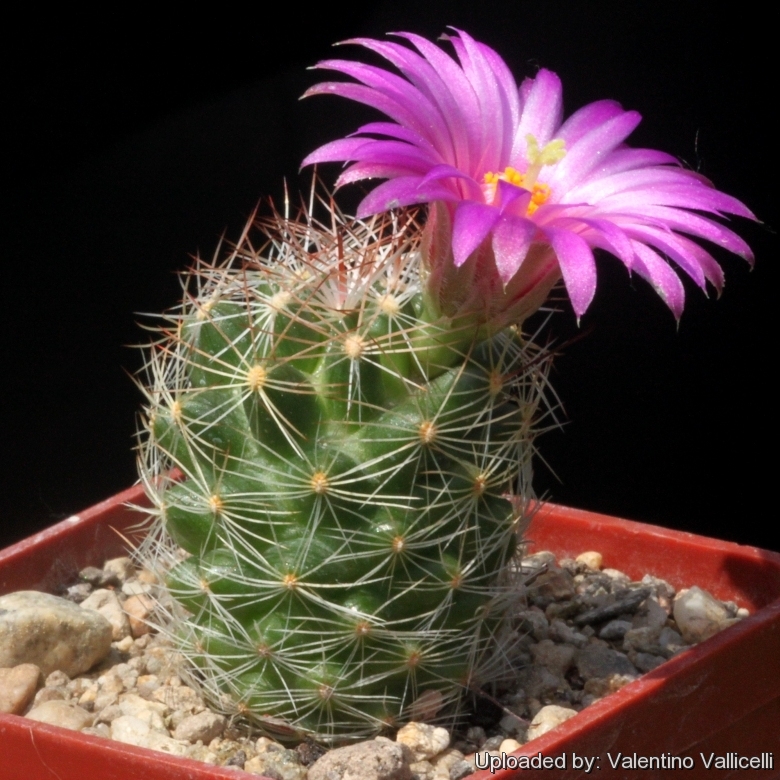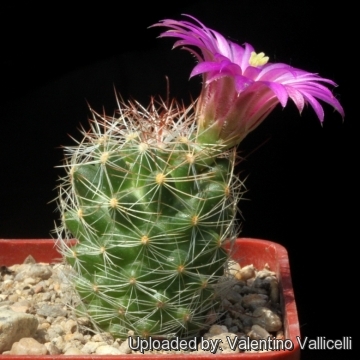Accepted Scientific Name: Mammillaria wrightii subs. wilcoxii (Toumey ex K.Schum.) D.R.Hunt
Mammillaria Postscripts 6: 5 (1997)

Neomammillaria wilcoxii (Mammillaria wrightii subs. wilcoxii) Photo by: Valentino Vallicelli
Origin and Habitat: New Mexico, Arizona, USA and Sonora, Chihuahua, Mexico.
Altitude: 700-2300 m.
Habitat: It grows in a arid environment with hot summers and cold winters (often snow-covered) in association with other succulents like Mammillaria grahamiiSN|9189]]SN|9189]] and Coryphantha aggregataSN|7168]]SN|7168]].
Synonyms:
See all synonyms of Mammillaria wrightii
Common Names include:
ENGLISH: Wilcox’s Pincushion, Wilcox’s Fishhook Cactus
Description: Mammillaria wilcoxii is a solitary plant without a large underground base, often regarded as a western form of Mammillaria wrightiiSN|9411]]SN|9411]].
Stem: Depressed, rounded, nearly spherical to short-cylindrical, flabby in texture, green to dull-green, up to 12 cm in diameter, but often much smaller about 5-6 cm in diameter. Without latex.
Tubercule arrangement: 5-8 or 8-13
Tubercles: Cylindrical to conical slightly flattened 5-20 mm long, bases about 5 mm wide.
Axil: Naked.
Areoles: Like in the other Mammillaria the areoles are dimorphic, with a circular to oval spinous part with short wool on the tip of the tubercles and the floral portion in the axil.
Radial spine: 14 - 16(-22), thin, bristle-like, slender and straight, white with slighter brown tips or occasianally the wole spine light brown, to 8-15 mm long, widely spreading outward and interlocking.
Central spine: Usually only 1, but sometime up to 5, of which 1 to 3 hooked, 2 cm long, stronger than the radials, brown, paler below. Under a lens the spines shows a fine down-like pubescence.
Flower: Campanulate, pink, pale rose to vivid purple, or rarely white, to 35 mm long and 30-40 mm in diameter when fully expanded. Outer perianth segments 20 brownish-green linener pointed and fringed with white hairs. Tepals about 40 in 2 rows, long narrow, pointed, reflexed, often with darker midveins and cream-coloured margins; Filaments white to pink with orangish-yellow anthers; Style 5-9 lobed green;
Fruit: Greenish, greenish-purple or brownish, obovate, 18-25 mm long up to 15 mm in diameter.<br />
Flowering period in Cultivation (Europe): May-june.
Seed: Black or blackish brown pitted almost round, about 1,7 mm long
Notes: The showy flowers of Mammillaria wilcoxiiSN|9404]]SN|9404]] are virtually identical to those of Coryphantha macromerisSN|10268]]SN|10268]] and Escobaria viviparaSN|9953]]SN|9953]]; in the absence of vegetative material, flowers may be unidentifiable.
Bibliography: Major references and further lectures
1) Robert T. Craig “The Mammillaria handbook: with descriptions, illustrations, and key to the species of the genus Mammillaria of the Cactaceae” E P Publishing, 1945
2) John Pilbeam “Mammillaria The Cactus File Handbook” Cirio Pub. Services, 01/Dec/1999
3) Edward Anderson “The Cactus family” Timber Press, Incorporated, 2001
4) James Cullen, Sabina G. Knees, H. Suzanne Cubey "The European Garden Flora Flowering Plants: A Manual for the Identification of Plants Cultivated in Europe, Both Out-of-Doors and Under Glass" Cambridge University Press, 11/Aug/2011
5) David R Hunt; Nigel P Taylor; Graham Charles; International Cactaceae Systematics Group. "The New Cactus Lexicon" dh books, 2006
6) Clive Innes, Charles Glass “Cacti” Portland House, 01/May/1991
7) N. L. Britton, J. N. Rose “The Cactaceae. Descriptions and Illustrations of Plants of the Cactus Family.” Volume 4, The Carnegie Institution of Washington, Washington 1923
 Neomammillaria wilcoxii (Mammillaria wrightii subs. wilcoxii) Photo by: Valentino Vallicelli
Neomammillaria wilcoxii (Mammillaria wrightii subs. wilcoxii) Photo by: Valentino Vallicelli Neomammillaria wilcoxii (Mammillaria wrightii subs. wilcoxii) Photo by: Valentino Vallicelli
Neomammillaria wilcoxii (Mammillaria wrightii subs. wilcoxii) Photo by: Valentino VallicelliCultivation and Propagation: Mammillaria wrightii var. wilcoxiiSN|9406]]SN|9406]] is a single stemmed species that comes from an area of summer rainfall. It is quite cold resistant, but the frost resistance varies a lot from clone to clone. It can easily be grown outdoors in areas with minimum winter temperatures of -15° C. It needs full sun to light shade.
Growth rate: It is slow growing.
Soils: It likes very porous standard cactus mix soil with little organic matter (peat, humus).
Repotting: Repotting every 2-3 years, or sooner if the roots get crowded. As it is prone to rot under-pot in a smaller container filled with very porous compost. Use pot with good drainage.
Watering: Water regularly in summer, but do not overwater (very wet-sensitively, especially in light of its succulent root system). Its roots are easily lost in pots that stay damp for any length of time. Keep dry with ample airflow in winter. In the rest period no high atmospheric humidity!! Care must be taken with watering as they tends to become swollen and untidy in growth habit if given too much water and shade.
Fertilization: During the growing season enrich the soil using a fertilizer rich in potassium and phosphorous, but poor in nitrogen, because this chemical element doesn’t help the development of succulent plants, making them too soft and full of water.
Hardiness: It is quite frost resistant if kept dry, hardy as low as -5° C (some reports give it hardy to -15°C or even less, , but the frost resistance varies a lot from clone to clone.). However some warmth throughout the year will increase the grower's success (minimum 5° C during rest season).
Exposition: Outside bright sun, filtered sunlight or afternoon shade, inside it needs bright light, and some direct sun. High levels of light are needed to flower and for good spine development. Can be sunburned if moved from shade/greenhouse into full sun too quickly. During the spring it may be able to take full sun until the heat arrives at the end of spring. In an area that has hot afternoon sun, it may be able to take full morning sun, but requires afternoon shade or afternoon light shade.
Uses: It is an excellent plant for container growing. It always looks good and stays small. It look fine in a cold greenhouse and frame.
Traditional uses: The white, hooked spines of this spherical cactus were used as fish hooks in its native Mexico.
Pests & diseases: It may be attractive to a variety of insects, but plants in good condition should be nearly pest-free, particularly if they are grown in a mineral potting-mix, with good exposure and ventilation. Nonetheless, there are several pests to watch for:
- Red spiders: Sensitive to red spider mite. Overhead watering is helpful in controlling mites.
- Mealy bugs: Occasionally mealy bugs they develop aerial into the new growth among the wool with disfiguring results, but the worst types develop underground on the roots and are invisible except by their effects.
- Scales: Scales are rarely a problem.
- Rot: Rot it is only a minor problem with cacti if the plants are watered and “aired” correctly. If they are not, fungicides won't help all that much.
Propagation: Direct sow after last frost or (usually). Seeds germinate in 7-14 days at 21-27° C in spring, remove the glass cover gradually as the plants develops and keep ventilated, no full sun for young plants! The seedlings should not be disturbed until they are well rooted, after which they can be planted separately in small pots.













